Software requirements
Introduction 
⭕️ What are Software Requirements
A requirement specifies a need to be fulfilled by the software product.
A software project may be,
- a brown-field project: develop a product to replace/update an existing software product
- a green-field project: develop a totally new system with no precedent
In either case, requirements have to be understood, discussed, refined, clarified, scoped.
Requirements come from stakeholders. {more}
Identifying requirements is not as straightforward as it sounds. It is not as simple as writing a wish list. {more details}
Non-functional requirements 
⭕️ Functional vs non-functional requirements
There are two different kinds of requirements:
- Functional requirements specify what the system should do.
- Non-functional requirements specify the constraints under which system is developed and operated. Some examples of non-functional requirements:
- Data requirements e.g. size, volatility, persistency etc.,
- Environment requirements e.g. technical environment in which system would operate or need to be compatible with.
- Accessibility, Capacity, Compliance with regulations, Documentation, Disaster recovery, Efficiency, Extensibility, Fault tolerance, Interoperability, Maintainability, Privacy, Portability, Quality, Reliability, Response time, Robustness, Scalability, Security, Stability, Testability, and more…
Non-functional requirements are easier to miss. We should spend extra effort in digging them out as early as possible because sometimes they are critical to the success of the software. E.g. A web application that is too slow or that has low security is unlikely to succeed even if it has all the right functionalities.
Gathering requirements 
⭕️ Some tools and techniques used for gathering requirements
- establishing requirements
- requirements elicitation
- requirements analysis
- requirements capture
Brainstorming 
- 🏆 Able to explain what is brainstorming

Brainstorming: A group activity designed to generate a large number of diverse and creative ideas for the solution of a problem.
In a brainstorming session there are no "bad" ideas. The aim is to generate ideas; not to validate them. Brainstorming encourages you to "think outside the box" and put "crazy" ideas on the table without fear of rejection.
🏆 Able to explain what is brainstorming ![]()
- 1. ...
- 2. ...
- 3. ...
- 1. ...
- 2.
- 3. ...
...
...
...
...
...
User Surveys 
- 🏆 Able to explain what user surveys are for

Carefully designed questionnaires can be used to solicit responses and opinions from a large number of users regarding any current system or a new innovation.
🏆 Able to explain what user surveys are for ![]()
- 1. ...
- 2. ...
- 3. ...
- 1. ...
- 2.
- 3. ...
...
...
...
...
...
Observation 
- 🏆 Able to explain what observation is for

Observation of users in their natural work environment is commonly used to understand the tasks and the environment of the user. Interaction logging on an existing system can also be used to gather information about how an existing system is being used.
🏆 Able to explain what observation is for ![]()
- 1. ...
- 2. ...
- 3. ...
- 1. ...
- 2.
- 3. ...
...
...
...
...
...
Interviews 
- 🏆 Able to explain what interviews are for

Interviewing potential stakeholders and domain experts can give us useful information about a domain, by getting users to explore what users feel about the required system. Interviews also provide opportunities for the development team members to meet stakeholders and to make stakeholders feel involved in the development process.
🏆 Able to explain what interviews are for ![]()
- 1. ...
- 2. ...
- 3. ...
- 1. ...
- 2.
- 3. ...
...
...
...
...
...
Focus Groups 
- 🏆 Able to explain what are focus groups

Focus Groups: A kind of informal interview within an interactive group setting.
In a focus group, a group of people (e.g. potential users, beta testers) are asked about their understanding of a specific issue or a process. Focus groups can bring out undiscovered conflicts and misunderstandings among stakeholder interests which can then be resolved or clarified as necessary.
🏆 Able to explain what are focus groups ![]()
- 1. ...
- 2. ...
- 3. ...
- 1. ...
- 2.
- 3. ...
...
...
...
...
...
Prototyping 
- 🏆 Able to explain what is prototyping

Prototype: A prototype is a mock up, a scaled down version, or a partial system constructed
- to get users’ feedback.
- to validate a technical concept (a "proof-of-concept" prototype).
- to give a preview of what is to come, or to compare multiple alternatives on a small scale before committing fully to one alternative.
- for early field-testing under controlled conditions.
Early UI prototyping, i.e. sketching the user interface for the intended product, is a good technique to uncover requirements, in particular, those related to how users interact with the system. UI prototypes are often used in brainstorming sessions, or in meetings with the users to get quick feedback from them.
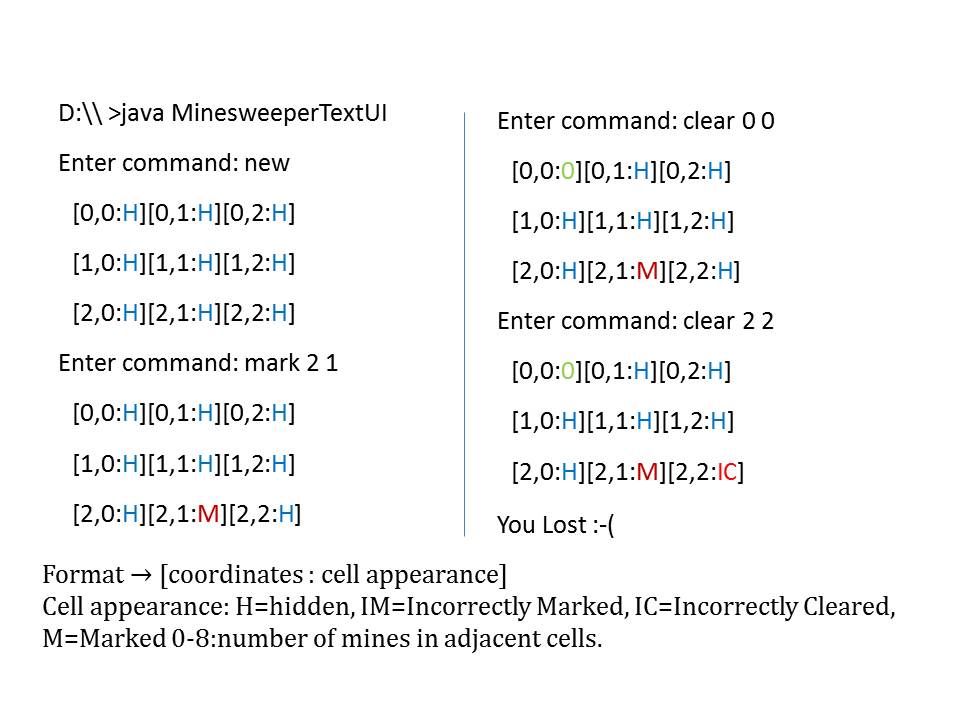
Simple text UI prototype for a primitive CLI (Command Line Interface) Minesweeper.
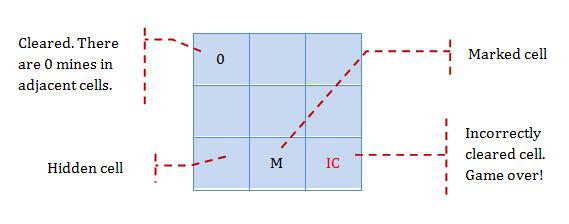
Simple GUI prototype for the same Minesweeper, created using Powerpoint
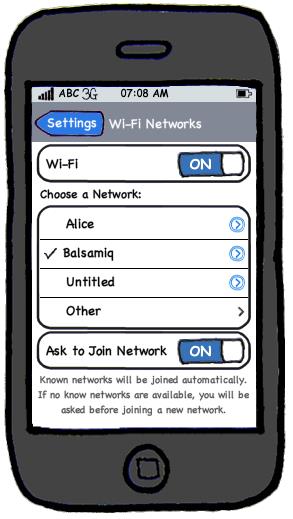
Prototyping can also be used as a technique for discovering as well as specifying what to build.
🏆 Able to explain what is prototyping ![]()
- 1. ...
- 2. ...
- 3. ...
- 1. ...
- 2.
- 3. ...
...
...
...
...
...
Product Surveys 
- 🏆 Able to explain what product surveys are for

Studying existing products can unearth shortcomings of existing solutions that can be addressed by a new product. For example, when developing a game for a mobile device, a look at a similar PC game can give insight into the kind of features and interactions the mobile game might offer. Product manuals and other forms of technical documentation of an existing system can be a good way to learn about how the existing solutions work.
🏆 Able to explain what product surveys are for ![]()
- 1. ...
- 2. ...
- 3. ...
- 1. ...
- 2.
- 3. ...
...
...
...
...
...
Specifying requirements 
⭕️ Some tools and techniques used for specifying requirements
Prose 
- 🏆 Able to explain what is a prose

A textual description (prose) can be used to give a quick overview of the domain/system that is understandable to both the users and the development team.
This is the most straight forward way of describing requirements, and is especially useful when describing the vision of a product.
🏆 Able to explain what is a prose ![]()
- 1. ...
- 2. ...
- 3. ...
- 1. ...
- 2.
- 3. ...
...
...
...
...
...
Feature List 
- 🏆 Able to explain what is a feature list

Feature List: A list of features (or functionalities) grouped according to some criteria such as priority (e.g. must-have, nice-to-have, etc. ), order of delivery, object or process related (e.g. order-related, invoice-related, etc.)
Here is a sample feature list from Minesweeper (only a brief description has been provided to save space):
- Basic play – Single player play.
- Difficulty levels – Additional Medium and Advanced levels.
- Versus play – Two players can play against each other.
- Timer – Additional fixed time restriction on the player.
🏆 Able to explain what is a feature list ![]()
- 1. ...
- 2. ...
- 3. ...
- 1. ...
- 2.
- 3. ...
...
...
...
...
...
User Stories 
Introduction 
- 🏆 Able to explain what is a user story

- 🏆 Able to write simple user stories in a known format

User story: User stories are short, simple descriptions of a feature told from the perspective of the person who desires the new capability, usually a user or customer of the system. [Mike Cohn]
A common format for writing user stories is:
User story format: As a {user type/role} I can {function} so that {benefit}
- As a student, I can download files uploaded by lecturers, so that I can get my own copy of the files
- As a lecturer, I can create discussion forums, so that students can discuss things online
- As a tutor, I can print attendance sheets, so that I can take attendance during the class
We can write user stories on index cards or sticky notes, and arrange on walls or tables, to facilitate planning and discussion. Alternatively, we can use a software such as GitHub Project Boards to manage user stories digitally.


[credit: https://www.flickr.com/photos/jakuza/with/2726048607/]
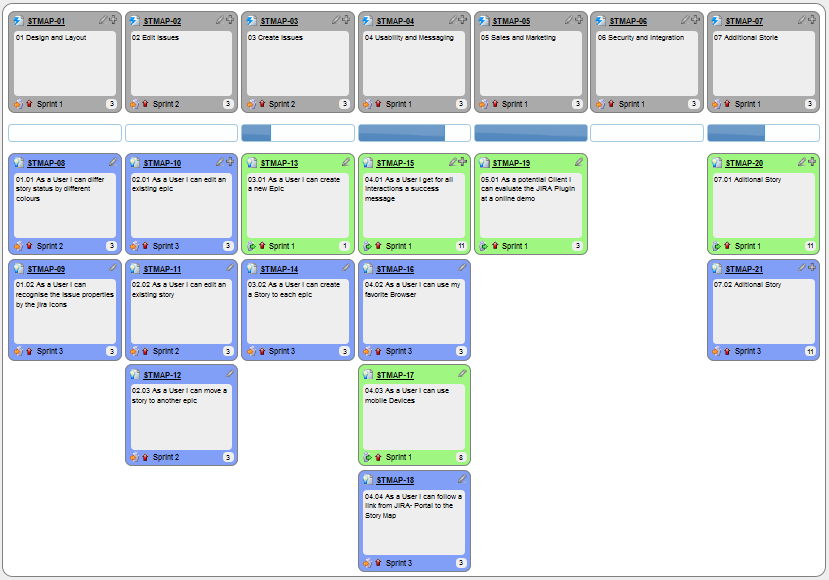
[credit: https://commons.wikimedia.org/wiki/File:User_Story_Map_in_Action.png]
🏆 Able to explain what is a user story ![]()
- 1. They are based on stories users tell about similar systems
- 2. They are written from the user/customer perspective
- 3. They are always written in some physical medium such as index cards or sticky notes
- 1. Reason: Despite the name, user stories are not related to 'stories' about the software.
- 2.
- 3. Reason: It is possible to use software to record user stories. When the team members are not co-located this may be the only option.
Critique the following user story taken from a software project to build an e-commerce website.
As a developer, I want to use Python to implement the software, so that we can resue existing Python modules.
Refer to the definition of a user story.
User story: User stories are short, simple descriptions of a feature told from the perspective of the person who desires the new capability, usually a user or customer of the system. [Mike Cohn]
This user story is not written from the perspective of the user/customer.
🏆 Able to write simple user stories in a known format ![]()
Bill wants you to build a Human Resource Management (HRM) system. He mentions that the system will help employees to view their own
Remember to follow the correct format when writing user stories.
User story format: As a {user type/role} I can {function} so that {benefit}
As an employee, I can view my leave balance, so that I can know how many leave days I have left.
Note: the {benefit} part may vary as it is not specifically mentioned in the question.
This video explains the rationale behind user stories. The video uses the term 'agile principles/processes'. If you don't know what that means, just think of it as 'a good thing to have'.
More detailed user stories 
- 🏆 Able to write more detailed user stories

The {benefit} can be omitted if it is obvious.
As a user, I can login to the system so that I can access my data
It is recommended to confirm there is a concrete benefit even if you omit it from the user story. If not, we could end up adding features that have no real benefit.
We can add more characteristics to the {user role} to provide more context to the user story.
- As a forgetful user, I can view a password hint, so that I can recall my password.
- As an expert user, I can tweak the underlying formatting tags of the document, so that I can format the document exactly as I need.
We can write user stories at various levels. High-level user stories, called epics (or themes) cover bigger functionality. We can then break down these epics to multiple user stories of normal size.
[Epic] As a lecturer, I can monitor student participation levels
- As a lecturer, I can view the forum post count of each student so that I can identify the activity level of students in the forum
- As a lecturer, I can view webcast view records of each student so that I can identify the students who did not view webcasts
- As a lecturer, I can view file download statistics of each student so that I can identify the students who do not download lecture materials
We can add conditions of satisfaction to a user story to specify things that need to be true for the user story implementation to be accepted as ‘done’.
- As a lecturer, I can view the forum post count of each student so that I can identify the activity level of students in the forum.
Conditions:
[ ] Separate post count for each forum should be shown
[ ] Total post count of a student should be shown
[ ] The list should be sortable by student name and post count
Other useful info that can be added to a user story includes (but not limited to)
- Priority: how important the user story is
- Size: the estimated effort to implement the user story
- Urgency: how soon the feature is needed
User stories for a travel website (credit: Mike Cohen)
- As a registered user, I am required to log in so that I can access the system
- As a forgetful user, I can request a password reminder so that I can log in if I forget mine
- [Epic] As a user, I can cancel a reservation
- As a premium site member, I can cancel a reservation up to the last minute
- As a non-premium member, I can cancel up to 24 hours in advance
- As a member, I am emailed a confirmation of any cancelled reservation
- [Epic] As a frequent flyer, I want to book a trip
- As a frequent flyer, I want to book a trip using miles
- As a frequent flyer, I want to rebook a trip I take often
- As a frequent flyer, I want to request an upgrade
- As a frequent flyer, I want to see if my upgrade cleared
🏆 Able to write more detailed user stories ![]()
...
...
...
...
Putting user stories to good use 
- 🏆 Able to use user stroies to manage requirements of project

User stories capture user requirements in a way that is convenient for
[User stories] strongly shift the focus from writing about features to discussing them. In fact, these discussions are more important than whatever text is written.
[Mike Cohn, MountainGoat Software 🔗]
User stories differ from
User stories can capture non-functional requirements too because even NFRs must benefit some stakeholder.
| As a | I want to | so that |
|---|---|---|
| impatient user | to be able experience reasonable response time from the website while up to 1000 concurrent users are using it | I can use the app even when the traffic is at the maximum expected level |
This article by Mike Cohn from MountainGoatSoftware explains how to use user stories to capture NFRs.
🏆 Able to use user stroies to manage requirements of project ![]()
...
Extreme programming (XP) is a software development methodology which is intended to improve software quality and responsiveness to changing customer requirements. As a type of agile software development, it advocates frequent "releases" in short development cycles, which is intended to improve productivity and introduce checkpoints at which new customer requirements can be adopted. [wikipedia, 2017.05.01]
This page in their website explains the difference between user stories and traditional requirements.
One of the biggest misunderstandings with user stories is how they differ from traditional requirements specifications. The biggest difference is in the level of detail. User stories should only provide enough detail to make a reasonably low risk estimate of how long the story will take to implement. When the time comes to implement the story developers will go to the customer and receive a detailed description of the requirements face to face.
Use Cases 
Introduction 
- 🏆 Able to explain what is a use case

- 🏆 Able to identify a use case diagram

- 🏆 Able to identify a use case description

Use Case: A description of a set of sequences of actions, including variants, that a system performs to yield an observable result of value to an
[ 📖 :
A use case describes an interaction between the user and the system for a specific functionality of the system.
System:
Use Case: Check account balance
- User inserts an ATM card
- ATM prompts for PIN
- User enters PIN
- ATM prompts for withdrawal amount
- User enters the amount
- ATM ejects the ATM card and issues cash
- User collects the card and the cash.
Unified Modeling Language (UML) http://www.uml.org/#UML2.0 is a graphical notation to describe various aspects of a software system. UML is the brainchild of three software modeling specialists James Rumbaugh, Grady Booch and Ivar Jacobson (also known as the Three Amigos). Each of them has developed their own notation for modeling software systems before joining force to create a unified modeling language (hence, the term ‘Unified’ in UML). UML is currently the de facto modeling notation used in the industry. This handout uses UML version 2.0.

Use cases can be used to capture the functional requirements of a system.
🏆 Able to explain what is a use case ![]()
- 1. ...
- 2. ...
- 3. ...
- 1. ...
- 2.
- 3. ...
...
...
...
🏆 Able to identify a use case diagram ![]()
...
...
...
🏆 Able to identify a use case description ![]()
...
...
...
...
...
Identifying use cases for a system 
- 🏆 Able to use use cases to list functional requirements of a simple system

A use case is an interaction between a system and its actors.
Actors in Use Cases
Actor: An actor (in a use case) is a role played by a user. An actor can be a human or another system. Actors are not part of the system; they reside outside the system.
Software system: LearnSys (a fictitious
Actors: Guest, Student, Staff, Admin, ExamSys (an exam management system), LibSys (a library management system).
A use case can involve multiple actors.
- Software System:
LearnSys - Use case:
UC01 conduct survey - Actors:
Staff,Student
An actor can be involved in many use cases.
- Software System:
LearnSys - Actor:
Staff - Use cases:
UC01 conduct survey,UC02 Set Up Course Schedule,UC03 Email Class, ...
A single person/system can play many roles.
- Software System:
LearnSys - Person:
a student - Actors (or Roles):
Student,Guest,Tutor
Many persons/systems can play a single role.
- Software System:
LearnSys - Actor(or role) :
Student - Persons that can play this role :
undergraduate student,graduate student,a staff member doing a part-time course,exchange student
{some guidance on identifying actors and use cases}
Use cases can be specified at various levels of detail.
- System:
LearnSys - Use cases:
- a.
Conduct a survey - b.
Take the survey - c.
Answer survey question
- a.
Consider the three use cases given above for the LearnSys system. Clearly, (a) is at a higher level than (b) and (b) is at a higher level than (c).
While modeling user-system interactions,
💡 Start with high level use cases and progressively work toward lower level use cases.
💡 Be mindful at which level of details you are working on and not to mix use cases of different levels.{some guidance on using diagrams vs other means}
🏆 Able to use use cases to list functional requirements of a simple system ![]()
Consider a simple movie ticket vending machine application. Every week, the theatre staff will enter the weekly schedule as well as ticket price for each show. A customer sees the schedule and the ticket price displayed at the machine. There is a slot to insert money, a keypad to enter a code for a movie, a code for the show time, and the number of tickets. A display shows the customer's balance inside the machine. A customer may choose to cancel a transaction before pressing the “buy” button. Printed tickets can be collected from a slot at the bottom of the machine. The machine also displays messages such as "Please enter more money”, “Request fewer tickets" or "SOLD OUT!”. Finally, a "Return Change" button allows the customer to get back his unspent money.
Draw a use case diagram for the above requirements.
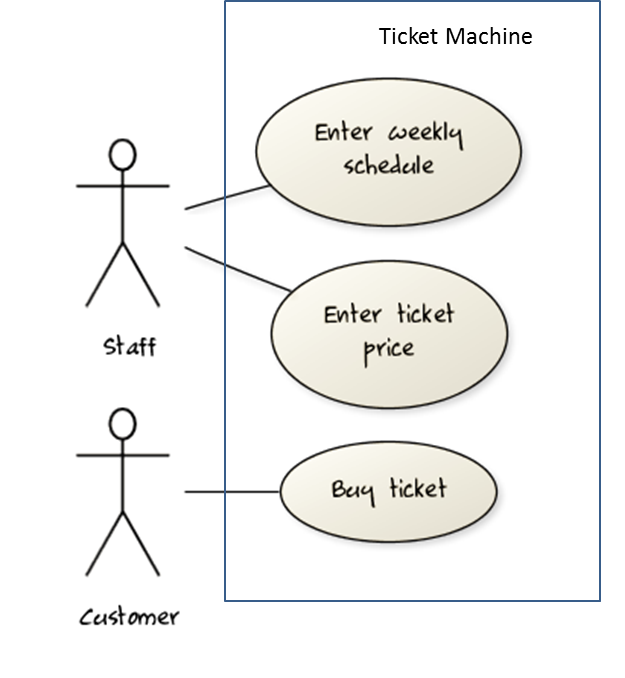
Note that most of the details in the description are better given as part of the use case description rather than as low-level use cases in the diagram.
A software house wishes to automate its Quality Assurance division.
The system is to be used by Testers, Programmers and System Administrators. Only an administrator can create new users and assign tasks to programmers. Any tester can create a bug report, as well as set the status of a bug report as ‘closed’. Only a programmer can set the state of a bug report to ‘fixed’, but a programmer cannot set the status of a bug report to ‘closed’. Each tester is assigned just one task at a time. A task involves testing of a particular component for a particular customer. Tester must document the bugs they find. Each bug is given a unique identifier. Other information recorded about the bug is component id, severity, date and time reported, programmer who is assigned to fix it, date fixed, date retested and date closed. The system keeps track of which bugs are assigned to which programmer at any given time. It should be able to generate reports on the number of bugs found, fixed and closed e.g. number of bugs per component and per customer; number of bugs found by a particular tester ; number of bugs awaiting to be fixed; number of bugs awaiting to be retested; number of bugs awaiting to be assigned to programmers etc.
Develop a use case diagram to capture their requirements given below.
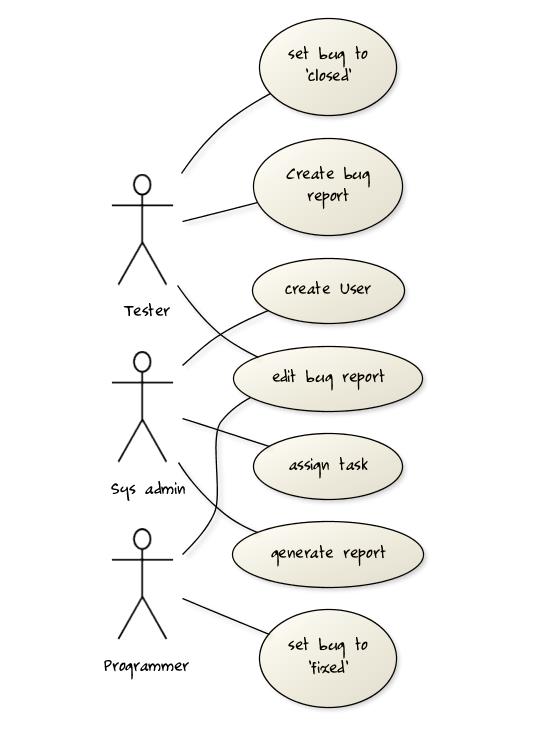
Explanation: The given description contains information not relevant to use case modeling. Furthermore, the description is not enough to complete the use case diagram All these are realities of real projects. However, the process of trying to create this use case diagram prompts us to investigate issues such as:
- Is ‘edit bug report’ a use case or editing the bug report is covered by other use cases such as those for setting the status of bug reports? If it is indeed a separate use case, who are the actors of that use case?
- Does ‘assign task’ simply means ‘assign bug report’ or is there any other type of tasks?
- There was some mention about Customers and Components. Does the system have to support use cases for creating and maintaining details about those entities? For example, should we have a ‘create customer record’ use case?
- Which actors can perform the ‘generate report’ use case? Are reports generated automatically by the system at a specific time or generated ‘on demand’ when users request to view them? Do we have to treat different types of reports as different use cases (in case some types of reports are restricted to some types of users)? The above diagram assumes (just for illustration) that the report is generated on demand and only the system admin can generate any report.
...
Writing detailed use cases 
- 🏆 Able to specify details of a use case in a structured format

Writing use case steps
The main body of the use case is the sequence of steps that describes the interaction between the system and the actors. Each step is given as a simple statement.
Use case:
- Staff creates the survey.
- Student completes the survey.
- Staff views the survey results. Use case ends.
A use case describes only the externally visible behavior, not internal details, of a system.
{give example}
Every step should clearly show who does what. A step gives the intention of the actor (not the mechanics). That means UI details are usually omitted. The idea is to leave as much flexibility to the UI designer as possible. That is, the use case specification should be as general as possible (less specific) about the UI. For example,
User right-clicks the text box and chooses ‘clear’: This contains UI-specific details and is not a good use case step.
User clears the input: This is better because it omits UI-specific details.
The following is an illustration of how we can include repetitive steps in a scenario.
Software System: Square game
Use case: UC02 - Play a Game
Actors: Player (multiple players)
1. A Player starts the game.
2. SquareGame asks for player names.
3. Each Player enters his own name.
4. SquareGame shows the order of play.
5. SquareGame prompts for the current Player to throw die.
6. Current Player adjusts the throw speed.
7. Current Player triggers the die throw.
8. Square Game shows the face value of the die.
9. Square Game moves the Player's piece accordingly.
Steps 5-9 are repeated for each Player, and for as many rounds as required until a Player reaches the 100th square.
10. Square Game shows the Winner.
Use case ends.
Main success scenario
The Main Success Scenario (MSS) describes the most straightforward interaction for a given use case, which assumes that nothing goes wrong. This is also called the Basic Course of Action or the Main Flow of Events of a use case. Given below is another example of an MSS.
System: Online Banking System (OBS)
Use case: UC23 - Transfer Money
Actor: User
MSS:
1. User chooses to transfer money.
2. OBS requests for details of the transfer.
3. User enters the requested details.
4. OBS requests for confirmation.
5. User confirms transfer.
6. OBS transfers the money and displays the new account balance.
Use case ends.
Extensions:
3a. OBS detects an error in the entered data.
3a1. OBS requests for the correct data.
3a2. User enters new data.
Steps 3a1-3a2 are repeated until the data entered are correct.
Use case resumes from step 4.
3b. User requests to effect the transfer in a future date.
3b1. OBS requests for confirmation.
3b2. User confirms future transfer.
Use case ends.
*a. At any time, User chooses to cancel the transfer
*a1. OBS requests to confirm the cancellation
*a2. User confirms the cancellation
Use case ends.
*b. At any time, 120 seconds lapse without any input from the User
*b1. OBS cancels the transfer
*b2. OBS informs the User of the cancellation
Use case ends.
Note how the MSS assumes that all entered details are correct and ignores problems such as timeouts, network outages etc. MSS does not tell us what happens if the user enters incorrect data.
Extensions
Extensions, given below the MSS, are "add-on"s to the MSS. They are also called exceptional flow of events or alternative flow of events. They describe variations of the scenario that can happen if certain things are not as expected by the MSS. Extensions appear below the MSS. Note that the numbering style is not a rule but just a convention. The third extension, labeled as ‘*a’ can happen at any step (hence, the ‘*’).
When separating extensions from the MSS, keep in mind that the MSS should be self-contained. That is, the MSS should give us a complete usage scenario. Also note that it is not useful to mention events such as power failures or system crashes as extensions because the system cannot function beyond such catastrophic failures.

<< extend >> relationship between use cases is used to capture extensions to the use cases. Note how the arrow is pointing the other way.
Inclusions
A use case can "include" another use case. Underlined text is commonly used to show an inclusion of a use case. Inclusions are useful,
- When you don't want to clutter a use case with too many low-level steps.
- When a set of steps is repeated in multiple use cases.
We use a dotted arrow and a << include >> annotation to show use case inclusions in a use case diagram.
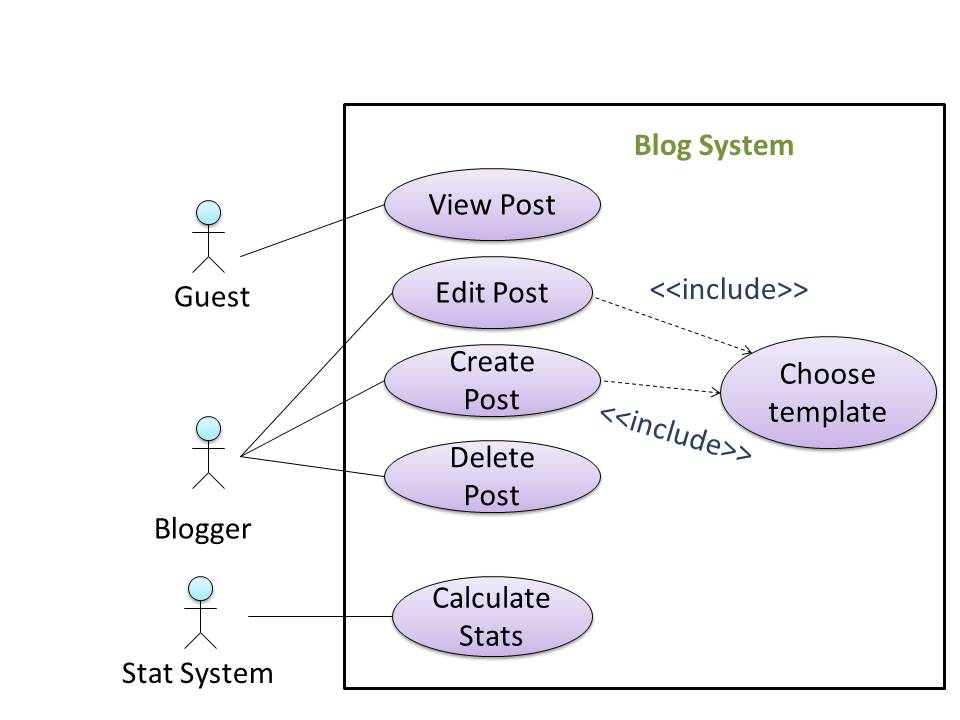
Use case preconditions
Preconditions specify the specific state we expect the system to be in before the use case starts.
Software System: Online Banking System
Use case: UC23 - Transfer Money
Actor: User
Preconditions: User is logged in.
MSS:
1. User chooses to transfer money.
2. OBS requests for details for the transfer.
...
Use case guarantees
Guarantees specify what the use case promises to give us at the end of its operation.
Software System: Online Banking System
Use case: UC23 - Transfer Money
Actor: User
Preconditions: User is logged in.
Guarantees:
* Money will be transferred to the destination account.
* All steps of the transaction will be logged.
MSS:
1. User chooses to transfer money.
2. OBS requests for details for the transfer.
...
🏆 Able to specify details of a use case in a structured format ![]()
Complete the following use case (MSS, extensions, etc.). Note that you should not blindly follow how the existing EZ-Link machine operates since it will prevent you from designing a better system. You should consider all possible extensions without complicating the use case too much.
System: EZ-Link machine (those found at MRTs)
Use case: UC2 top-up EZ-Link card
Actor: EZ-Link card user
System: EZ-Link machine (those found at MRTs)
Use case: UC2 top-up EZ-Link card
Actor: EZ-Link card user
Preconditions: All hardware in working order.
Guarantees: MSS -> the card will be topped-up.
MSS:
1. User places the card on the reader.
2. System displays card details and prompts for desired action.
3. User selects top-up.
4. System requests for top-up details (amount, payment option, receipt required?).
5. User enters details.
6. System processes cash payment (UC02) or NETS payment (UC03).
7. System updates the card value.
8. System indicates transaction as completed.
9. If requested in step 5, system prints receipt.
10. User removes the card.
Use case ends.
Extensions:
*a. User removed card or other hardware error detected.
*a1. System indicates the transaction has been aborted.
Use case ends.
Notes:
- We assume that the only way to cancel a transaction is by removing the card.
- By not breaking step 4 into further steps, we avoid committing to a particular mechanism to enter data. For example, we are free to accept all data in one screen.
- In step 5, we assume that the input mechanism does not allow any incorrect data.
System: EZ-Link machine
Use case: UC03 process NETS payment
Actor: EZ-Link card user
Preconditions: A transaction requiring payment is underway.
Guarantees: MSS → Transaction amount is transferred from user account to EZ-Link company account.
MSS:
1. System requests to insert ATM card.
2. User inserts the ATM card.
3. System requests for PIN.
4. User enters PIN.
5. System reports success.
Use case ends.
Extensions:
2a. Unacceptable ATM card (damaged or inserted wrong side up).
…
4a. Wrong PIN.
…
4b. Insufficient funds.
…
*a. Connection to the NETS gateway is disrupted.
…
Note: UC02 can be written along similar lines.
Complete the following use case (MSS, extensions, etc.).
System: LearnSys
Use case: UC01 reply to post in the forum
Actor: Student
System: LearnSys
Use case: UC01 reply to post in the forum
Actor: Student
Preconditions: Student is logged in and has permission to post in the forum. The post to which the Student replies already exists.
Guarantees: * MSS -> post will be added to the forum.
MSS:
1. Student chooses to reply to an existing post.
2. LearnSys requests the user to enter post details.
3. Student enters post details.
4. Student submits the post.
5. LearnSys displays the post.
Use case ends.
Extensions:
*a. Internet connection goes down.
…
*b. LearnSys times out.
…
3a. Student chooses to ‘preview’ the post.
3a1. LearnSys shows a preview.
3a2. User chooses to go back to editing.
Use case resumes at step 3.
3b. Student chooses to attach picture/file
…
3c. Student chooses to save the post as a draft.
3c1. LearnSys confirms draft has been saved.
Use case ends.
3d. Student chooses to abort the operation.
…
4a. The post being replied to is deleted by the owner while the reply is being entered.
…
4b. Unacceptable data entered.
…
...
Putting use cases into good use 
- 🏆 Able to optimize the use of use cases

More on use case diagrams
Actor generalization
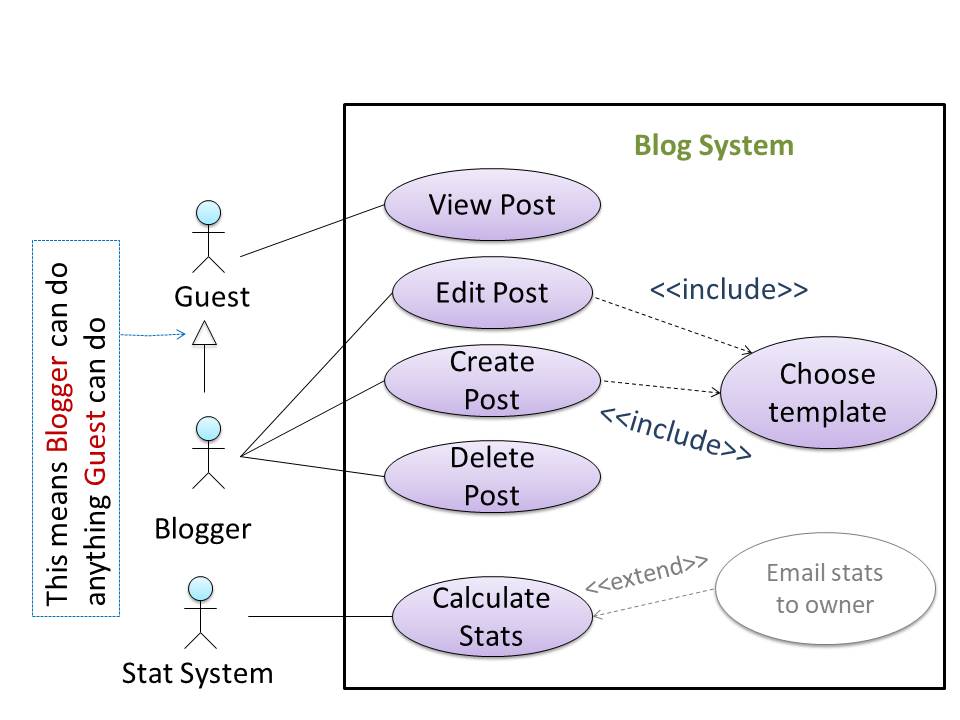
Do not over-complicate use case diagrams.
System as an actor
Some include ‘System’ as an actor to indicate that something is done by the system itself without being initiated by a user or an external system. For example, the diagram below can be used to indicate that the system generates daily reports at midnight.
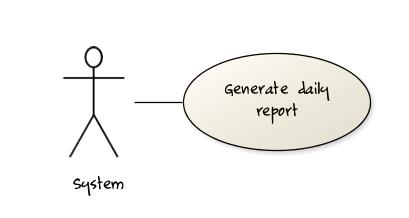
However, others argue that only use cases providing value to an external user/system should be shown in the use case diagram. For example, they argue that ‘view daily report’ should be the use case and ‘generate daily report’ is not to be shown in the use case diagram because it is simply something the system has to do to support the ‘view daily report’ use case.
We recommend that you follow the latter view (i.e. not to use System as a user). Limit use cases for modeling behaviors that involve an external actor.
More on use case descriptions
UML is not very specific about the text contents of a use case. Hence, there are many styles for writing use cases. For example, the steps can be written as a continuous paragraph. Use cases should be easy to read. Note that there is no strict rule about writing all details of all steps or a need to use all the elements of a use case.
Pros and cons
Here are some of the advantages of documenting system requirements as use cases:
- Since they use a simple notation and plain English descriptions, they are easy for users to understand and give feedback.
- They decouple user intention from mechanism (note that use cases should not include UI-specific details), allowing the system designers more freedom to optimize how a functionality is provided to a user.
- Identifying all possible extensions encourages us to consider all situations that a software product might face during its operation.
- Separating typical scenarios from special cases encourages us to optimize the typical scenarios.
One of the main disadvantages of use cases is that they are not good for capturing requirements that does not involve a user interacting with the system. Hence, they should not be used as the sole means to specify requirements.
Glossary 
- 🏆 Able to explain what is a glossary

Glossary: A glossary serves to ensure that all stakeholders have a common understanding of the noteworthy terms, abbreviation, acronyms etc.
As an example, here is a partial glossary from a variant of the Snakes and Ladders game:
- Conditional square: A square that specifies a specific face value which a player has to throw before his/her piece can leave the square.
- Normal square: a normal square does not have any conditions, snakes, or ladders in it.
🏆 Able to explain what is a glossary ![]()
- 1. ...
- 2. ...
- 3. ...
- 1. ...
- 2.
- 3. ...
...
...
...
...
...
Supplementary Requirements 
- 🏆 Able to explain what supplementary requirements are for

A supplementary requirements section contains elements which do not fit elsewhere.
Examples of of requirements typically found under this heading include:
- Business/domain rules: e.g. the size of the minefield cannot be smaller than five.
- Constraints: e.g. the system should be backward compatible with data produced by earlier versions of the system; system testers are available only during the last month of the project; the total project cost should not exceed $1.5 million.
- Technical requirements: e.g. the system should work on both 32-bit and 64-bit environments.
- Performance requirements: e.g. the system should respond within two seconds.
- Quality requirements: e.g. the system should be usable by a novice who has never carried out an online purchase.
- Process requirements: e.g. the project is expected to adhere to a schedule that delivers a feature set every one month.
- Notes about project scope: e.g. the product is not required to handle the printing of reports.
- Any other noteworthy points: e.g. the game should not use images deemed offensive to those injured in real mine clearing activities.
🏆 Able to explain what supplementary requirements are for ![]()
- 1. ...
- 2. ...
- 3. ...
- 1. ...
- 2.
- 3. ...
...
...
...
...
...
Prioritizing requirements 
⭕️ Deciding the relative importance of the requirements gathered
Short timelines and limited resources often mean that you cannot implement all requirements at once. A prioritization criterion can be used to gauge the importance and urgency of requirements from the user point of view, while keeping in mind the constraints of schedule, budget, staff resources, and quality goals as seen by the development team.
A common approach to prioritization is to group requirements into priority categories. Note that all such scales are subjective, and stakeholders define the meaning of each level in the scale for the project at hand.
Here is an example:
Essential: The product must have this requirement fulfilled else it does not get user acceptanceTypical: Most similar systems have this feature although the product can survive without it.Novel: New features that could differentiate this product from the rest.
More examples:
High,Medium,LowMust-have,Nice-to-have,Unlikely-to-have
At the same time, some requirements may get discarded as they are considered ‘out of scope’.
Quality of requirements 
⭕️ Guidance on writing good quality requirements
Here are some characteristics of well-defined requirements
- Unambiguous
- Testable (verifiable)
- Clear (concise, terse, simple, precise)
- Correct
- Understandable
- Feasible (realistic, possible)
- Independent
- Atomic
- Necessary
- Implementation-free (abstract)
Besides these criteria for individual requirements, the set of requirements as a whole should be
- Consistent
- Non-redundant
- Complete
Peter Zielczynski, Requirements Management Using IBM Rational RequisitePro, IBM Press, 2008
